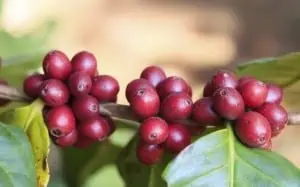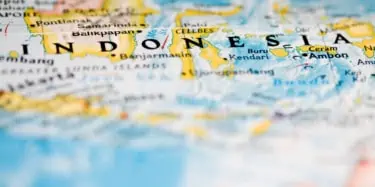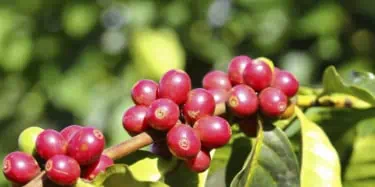Guatemala is rivaled only by Kenya as coffee insiders' favorite origin. The terrible ravages of decades of brutal civil war have ironically helped preserve that position, since those years of disorder discouraged the technification of Guatemala coffee, meaning the replacement of heirloom, shade-grown varieties of Coffea arabica with hybrid, full-sun varieties heavily dependent on chemical
Extreme and Not-So-Extreme Dark Roasts
I often am accused of "not liking" dark-roasted coffee. Whereupon I try to explain that what I don't like are bad dark roasts: thin-bodied, burned dark roasts. Tactfully developed dark roasts, those in which the sugars have been caramelized rather than burned and in which enough fat survives to smooth the cup, are fine with me. And if some nuance also survives, or better yet, transforms in some
A Dozen Keepers
The twelve coffees reviewed here represent a sort of best-of-category selection of coffees that have made their way to my table over the last couple of months. The four Hawaii coffees are new offerings from this past winter's 1998/99 crop, as is the Jamaica Blue Mountain. The three blends are either new to everyone (The Roasterie's Fifth Anniversary Blend) or new to me. The Allegro Yemen, the
Indonesias and Papua New Guineas
Sumatra probably became America's favorite Indonesia coffee because in the early days of specialty coffee it seemed the most distinctive origin from the region: heavier and richer than Java, twistier and more complex than Papua New Guinea, a bit more consistent and accessible than similar coffees from Sulawesi. And back then, East Timor, the source of two of the Indonesia coffees in this month's
Kenyas and Other East Africas
Specialty coffee professionals tend to be protective of Kenya. For one thing, it remains the world's single most consistent source of superlative coffee. And Kenya is superlative in the particular ways American specialty professionals define superlative: alive with the dry, vibrant sensation called acidity, fruity without cloying sentiment, big and resonant.Furthermore, most specialty folks admire
New Crop Sumatra Coffees
Back in 1975, when I wrote my first book on coffee, Sumatras were a revelation: long, tawny-colored beans with a wonderful deep-toned, bass-tickling richness. The cup was heavy, but alive with fruit and smoke. The bags came marked with sonorous names like Mandheling and Lintong. It was easy to project Conradian into those names and that dark luxuriousness. Those archetypal Sumatras I first
Brazil and Brazils
Evaluating coffees apart from the people who grow them is sometimes difficult. It becomes particularly difficult when the people in question are as charming and lavishly hospitable as the Brazilian growers whom I visited last month. I ate very well, shared much generous laughter, and here and there cupped some very impressive coffees. I was moving in the learned wake of George Howell, whom some
Holiday Gift Coffees
Holiday coffees pose a challenge to both buyer and seller. Coffee is one of the great habitual, everyday luxuries. Holiday gifts, on the other hand, are supposed to be exceptional, not habitual, and not everyday. That conflict leaves roasters scrambling to find plausible ways to cash in on the holiday buying debauch with coffees that appear unique to the season, while consumers try to figure out
Single-Origin Organic Coffees
The specialty coffee business was founded on a sort of practical idealism. The great iconoclastic tradition of the coffee house, coffee's myth-embellished history as the beverage of the people, the anti-corporate stance of the early specialty coffee culture, all seemed to attract leaders who were interested in making a difference as well as in making a living. Some years ago, however, a couple
Best Sellers
The coffees that sell best in the American specialty marketplace often are not the same coffees that American specialty coffee professionals (and reviewers) would like to see sell the best. It occurred to me to ask a selection of regional roasters for the coffees their customers prefer, as opposed to the coffees they prefer as professionals. Coffee Review staff members approached six
Twelve Hits from ’98
I've just finished washing the cups and brushing out the grinder after cupping about 180 coffees (including 35 or so espressos) from twenty distinguished American specialty roaster-retailers. The reason for all the cupping is explained elsewhere in this issue. It seems worthwhile, however, to report on a little of what I learned (or think I learned) during my marathon cupping. (The twelve
Caribbean Coffees
However closely Caribbean coffees resemble one another in their full, rounded coastal flavor profiles, their individual stories are quite different. The Blue Mountain coffees of Jamaica are among the world's most expensive, sought after by price-is-no-object romantics, while resented by many coffee professionals for their high price. The Yauco coffees of Puerto Rico represent a successful revival
Costa Rican Coffees
Costa Rica is one of those classic coffee origins that is respected but generally not fawned over. Although Costa Rica produces a variety of coffees, those that reach American specialty coffee menus typically are high-grown "Strictly Hard Bean" (SHB) coffees from growing regions near the capital of San Jose in the west-central part of the country. At best SHB coffees are distinctive in a way that
West-Coast Espressos
The West Coast is doubtless the cradle of American espresso culture. True, Caffe Dante and Caffe Reggio were serving cappuccino in Manhattan long before the pioneering San Francisco and Berkeley caffes opened, and little storefront social clubs served espresso to domino and card players in Italian neighborhoods across the country for decades. But the whole business broke out of Italian enclaves
Hawaiian Coffees
A blind cupping of Hawaiian coffees provokes two interesting issues: First, how good is Kona? Is it a rip-off at $ 16 a pound green and $25 to $35 per pound retail? Or is this most traditional of Hawaiian coffees simply a very fine origin that has the further good luck to be scarce and expensive? Second, how good are the "other island" coffees, the new "non-Kona" Hawaiis from Kauai and
Sumatra Coffees
Sumatra is one of the world's most distinctive coffee origins. Full-bodied, resonant, low-toned and elegantly comfortable, it attracts coffee drinkers who find the powerfully acidy coffees of Kenya and Central America too high-pitched and softer coffees like Konas, Mexicos and Brazils too delicate. Sumatra's relaxed power doesn't depend on acidity, rather on depth, weight and echoing
Brazils
For coffee insiders and aficionados a cupping of Brazilian coffees raises interesting issues. Until recently, Brazil was known as the provider of two broad classes of coffee. One, an inexpensive arabica coffee that is raised at low altitudes, stripped from the trees in a single indiscriminate picking, and sun-dried on patios so vast that the motley heaps of drying coffee fruit and leaves are moved
Mocha-Java Blends
Buying Mocha-Java blends is like listening to jazz ensembles cover Autumn Leaves; the melody may be the same but the interpretations sure aren't. Kevin Knox of Allegro Coffee tells a story from the early, pre-corporate days at Starbucks, when the company named its Mocha-Java blend "Revolutionary" Mocha-Java. Revolutionary because people were actually told what was in it. Both the enduring
Holiday Coffees 1997
Inevitably, here we go with an assortment of holiday coffees. Coffees, not blends, because some roasters now approach the holidays with the idea that their special seasonal offering doesn't need to be a unique blend, but perhaps a single-origin, unblended coffee that is offered only once during the year. Thus the cupping includes a Mexico Maragogipe from Gevalia and a special, premium Kenya from
Environment-Friendly Coffees
Of all of the behind-the-scenes debates that grumble their way through coffee cupping rooms, those that cluster around coffee and the environment mutter the loudest. Are environmentally progressive coffees simply second-rate beans masquerading under a growing lexicon of buzz words like organic, shade-grown, bird-friendly, and the latest and grandest, sustainable? Should coffee consumers be





























